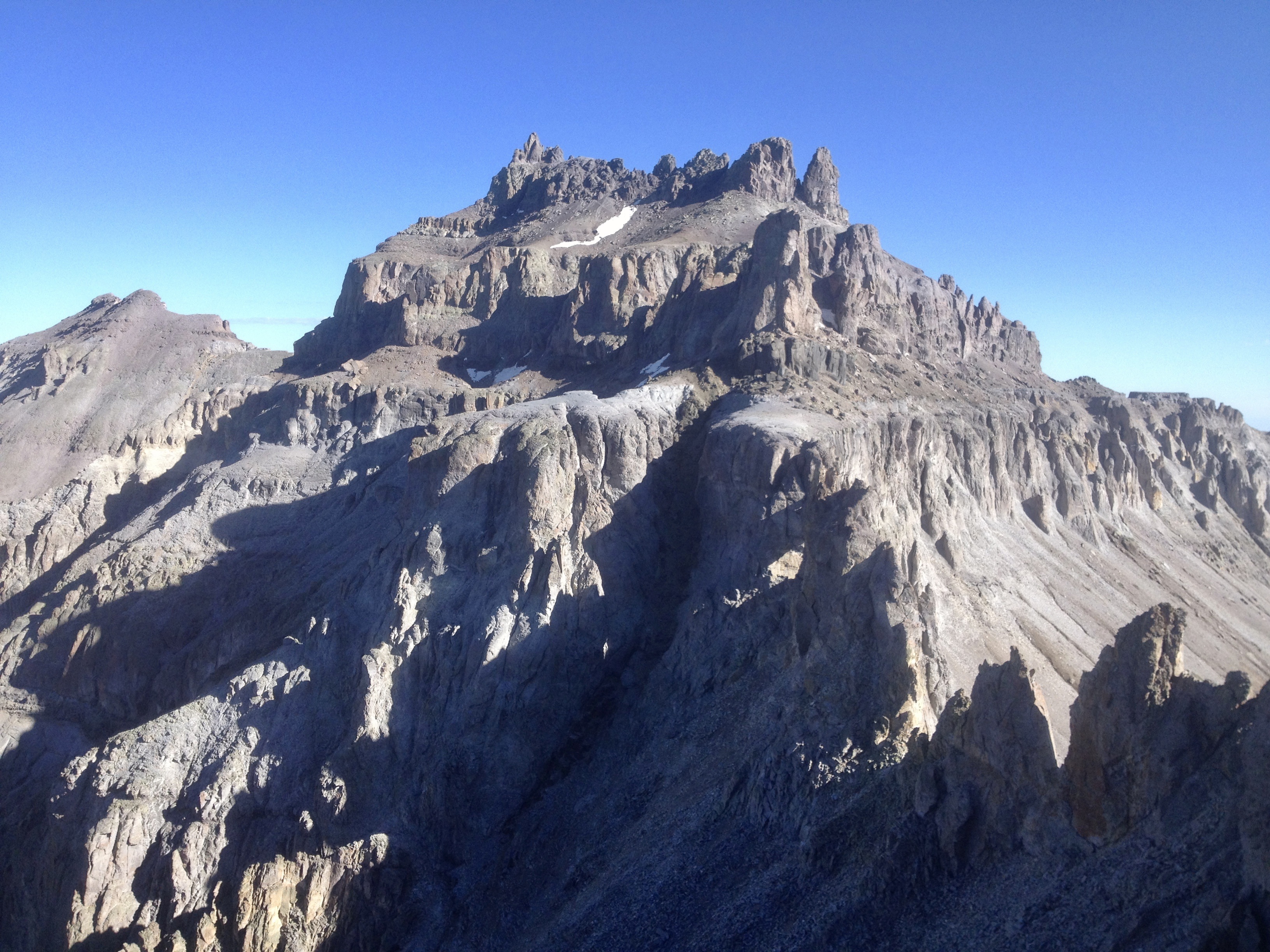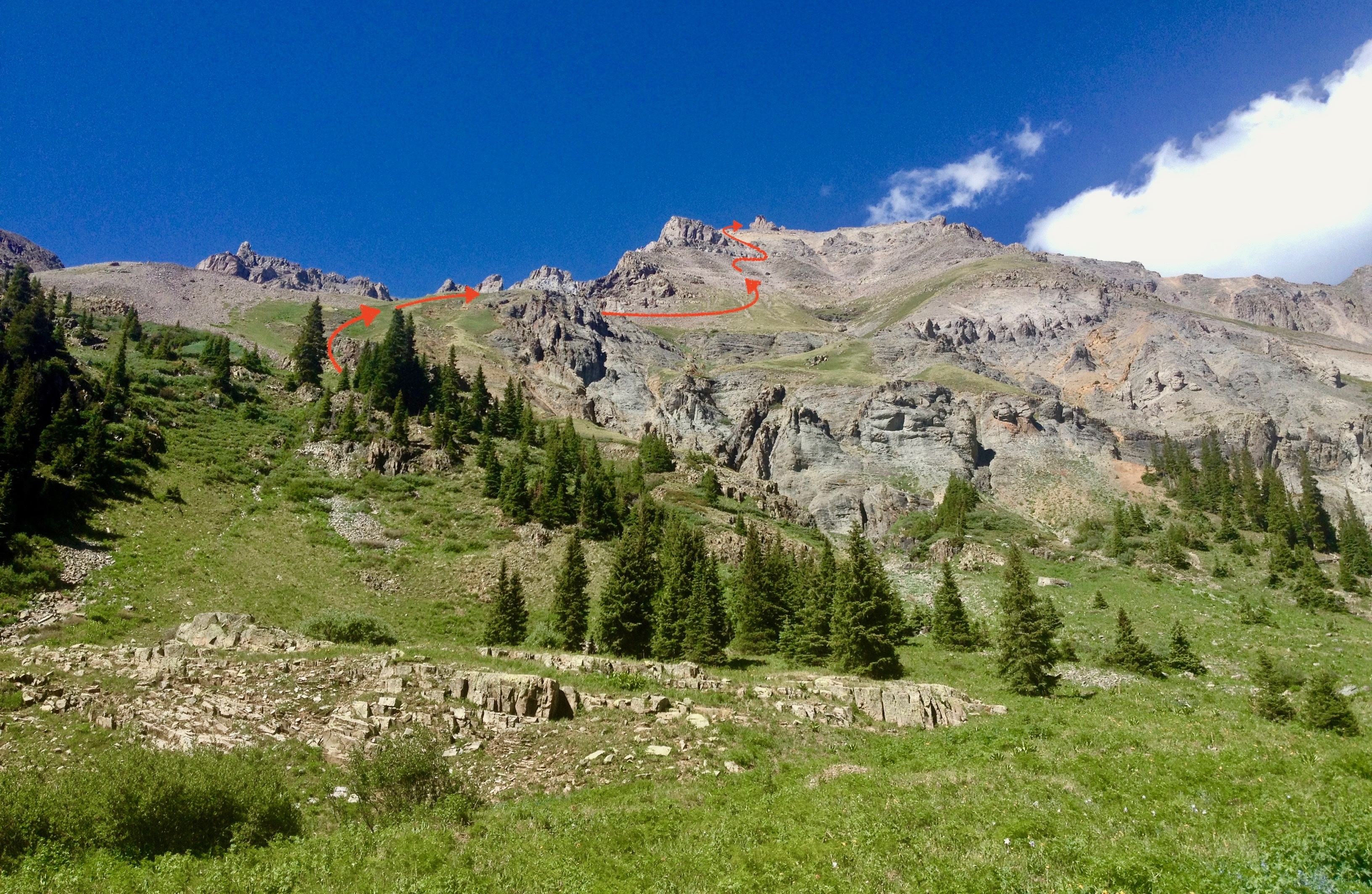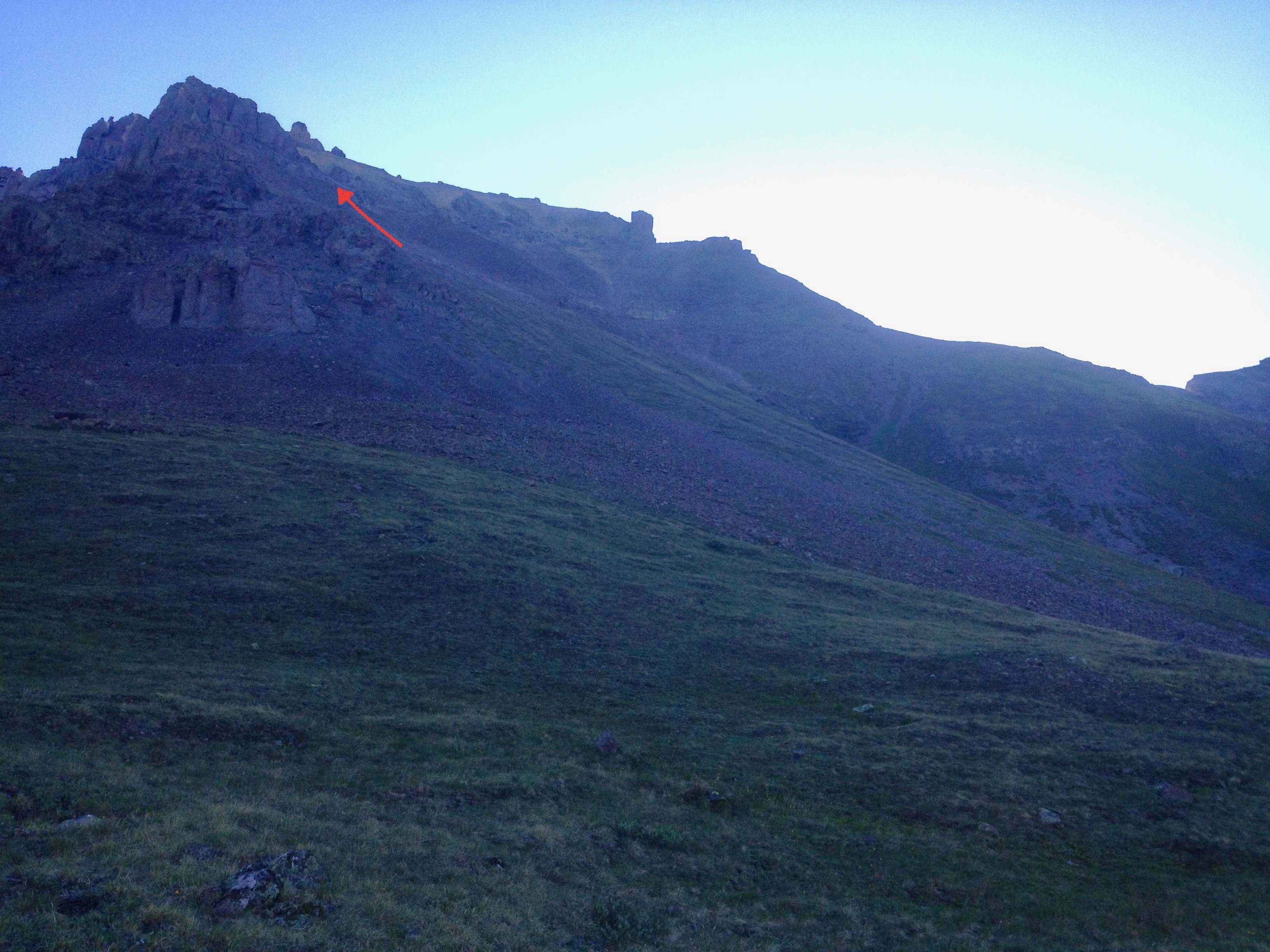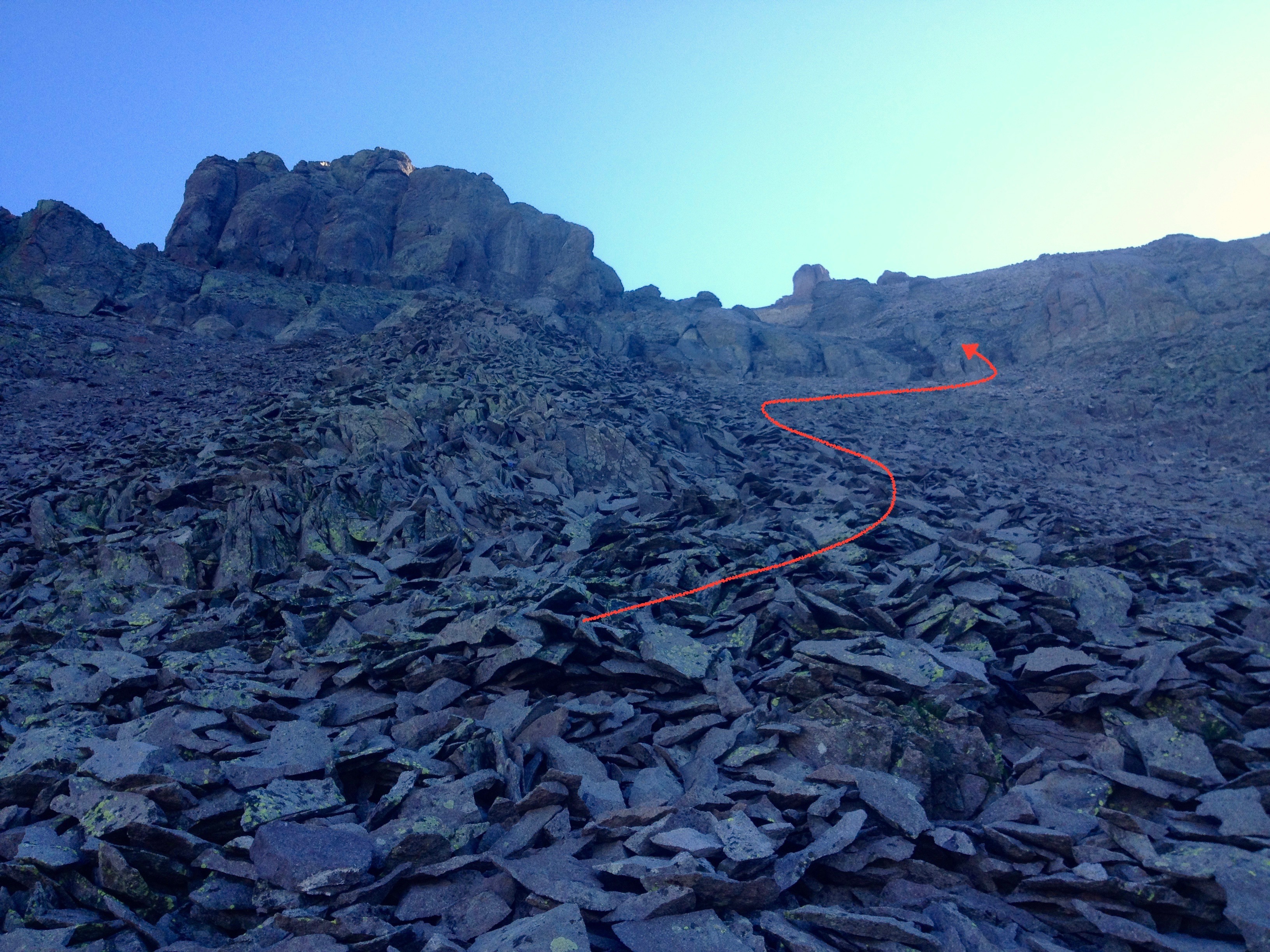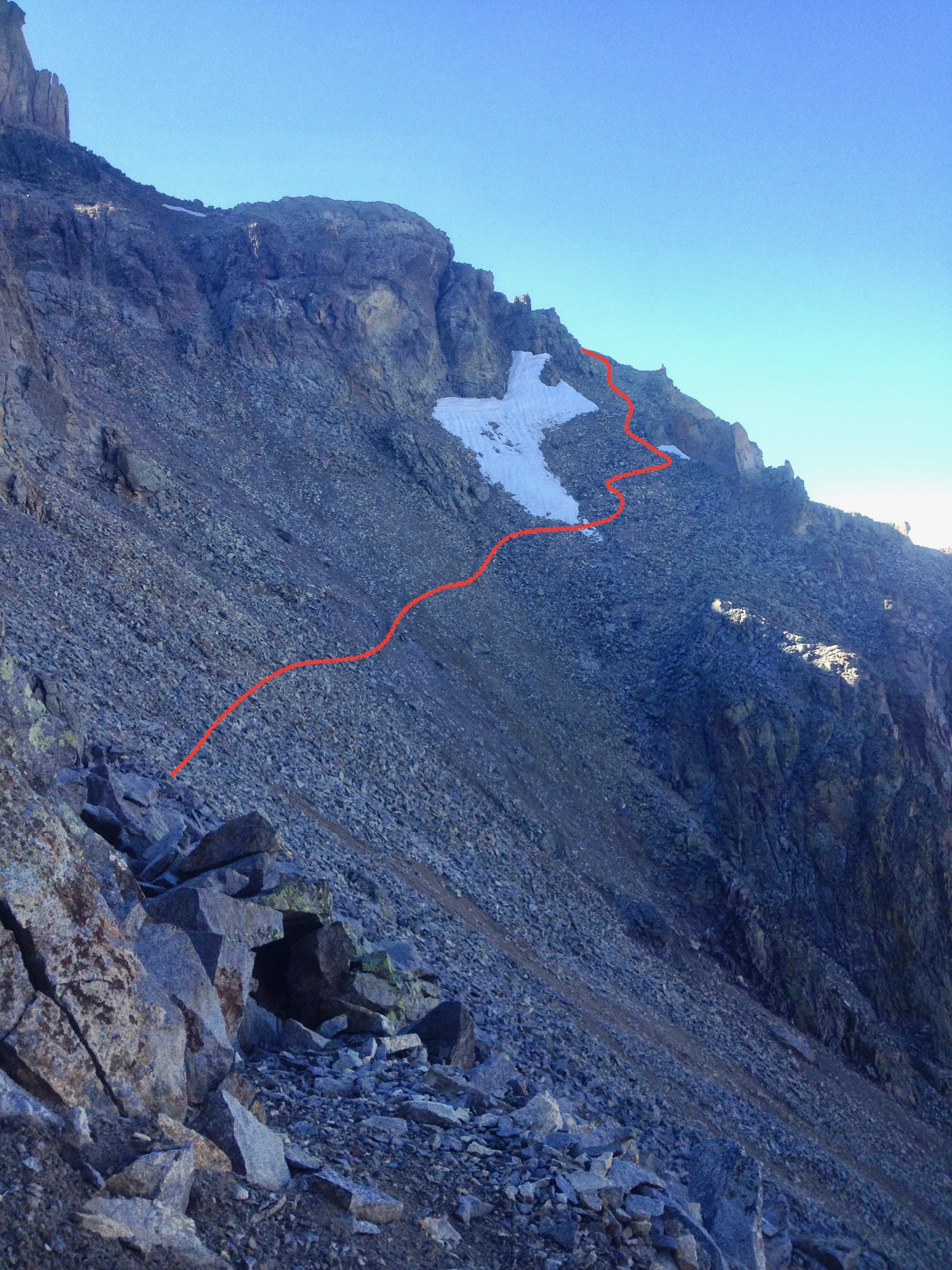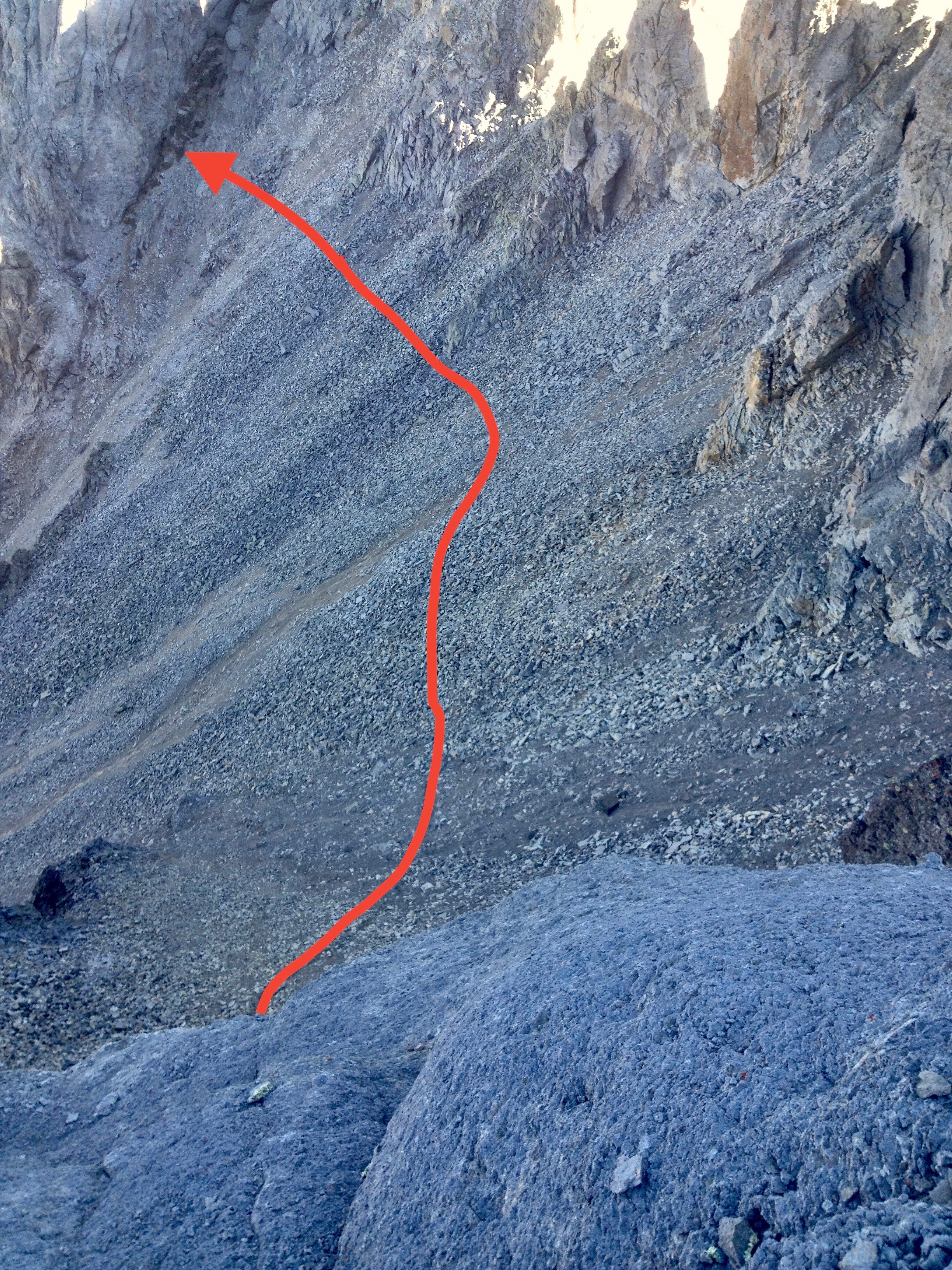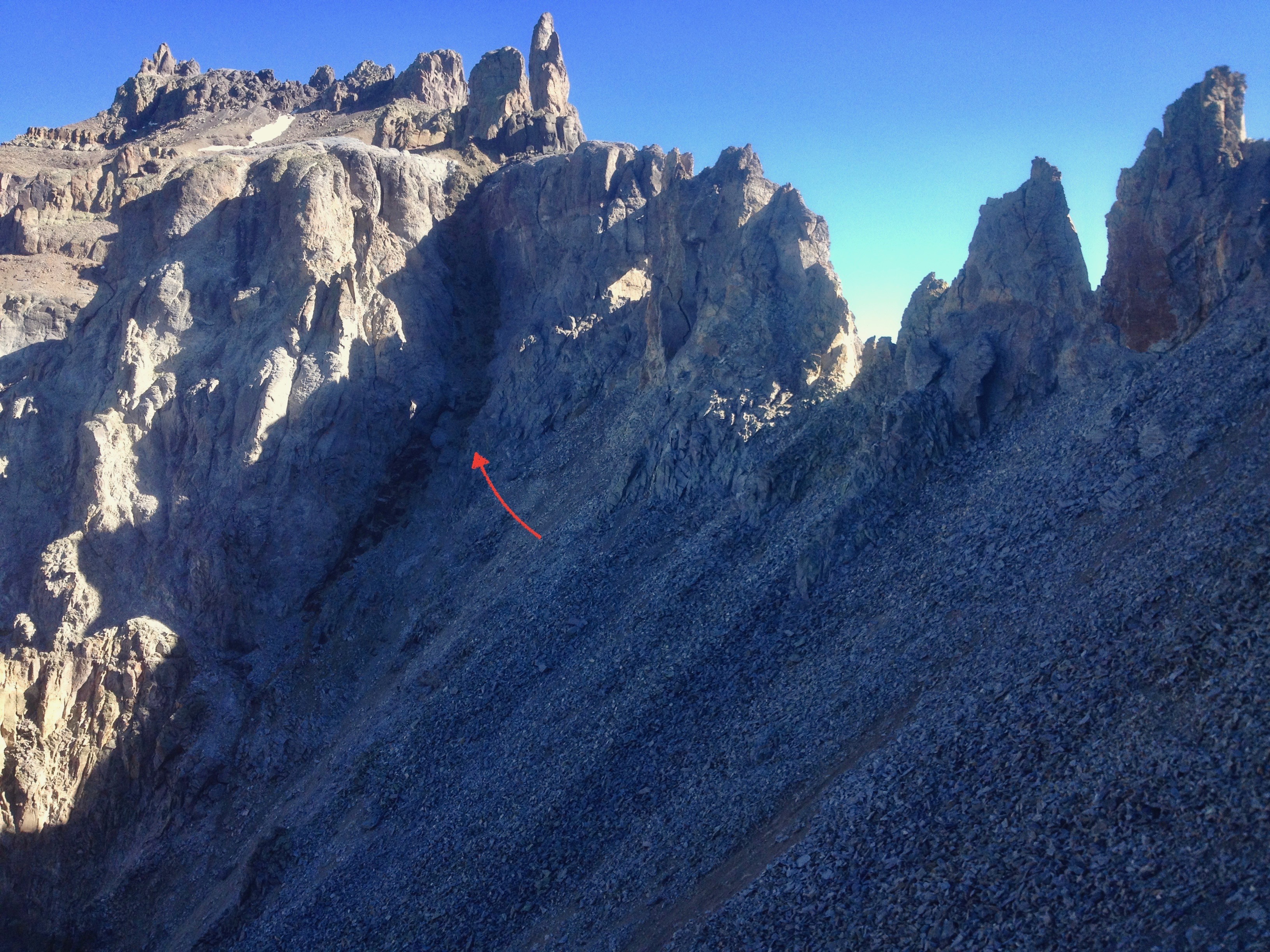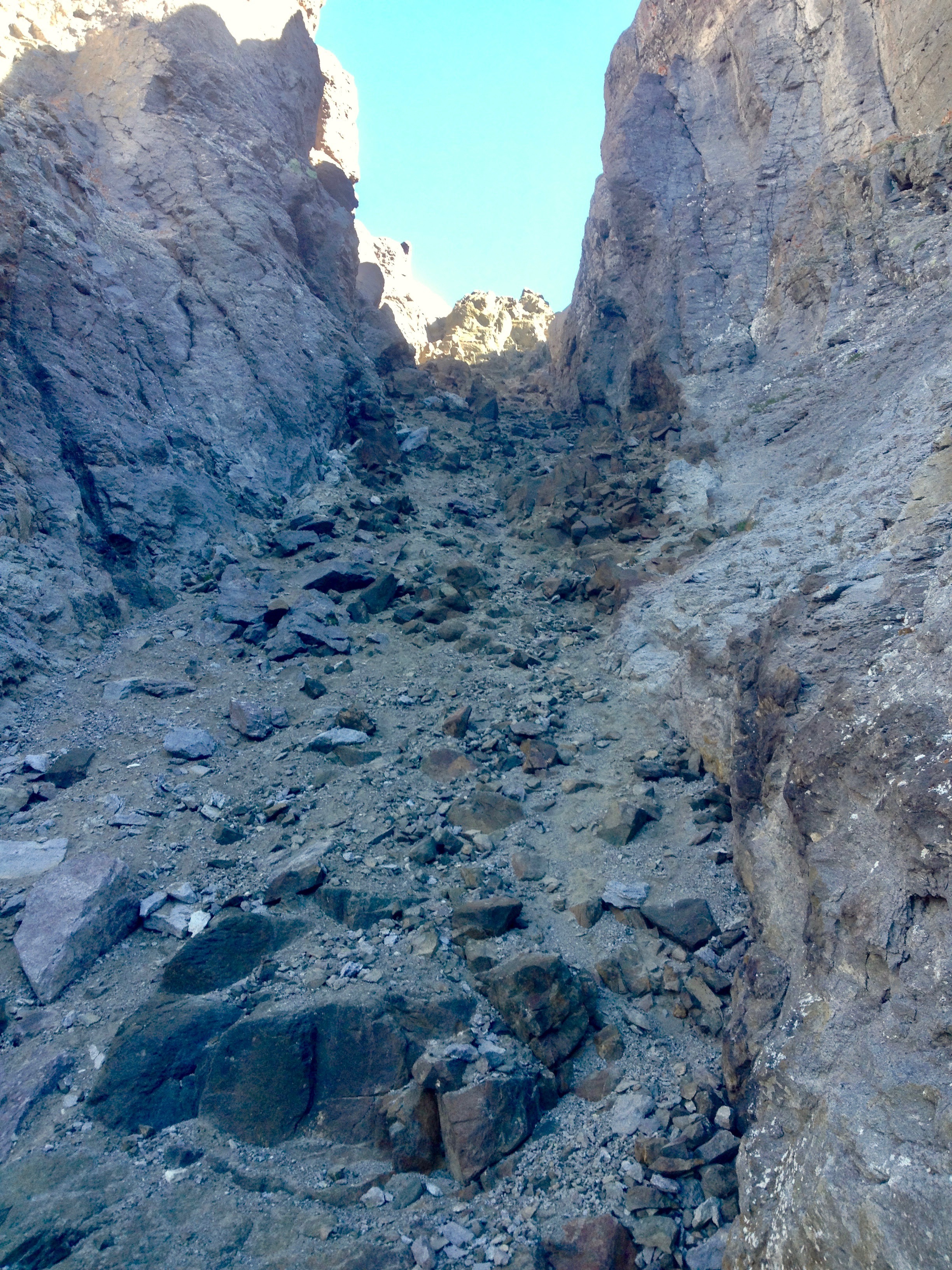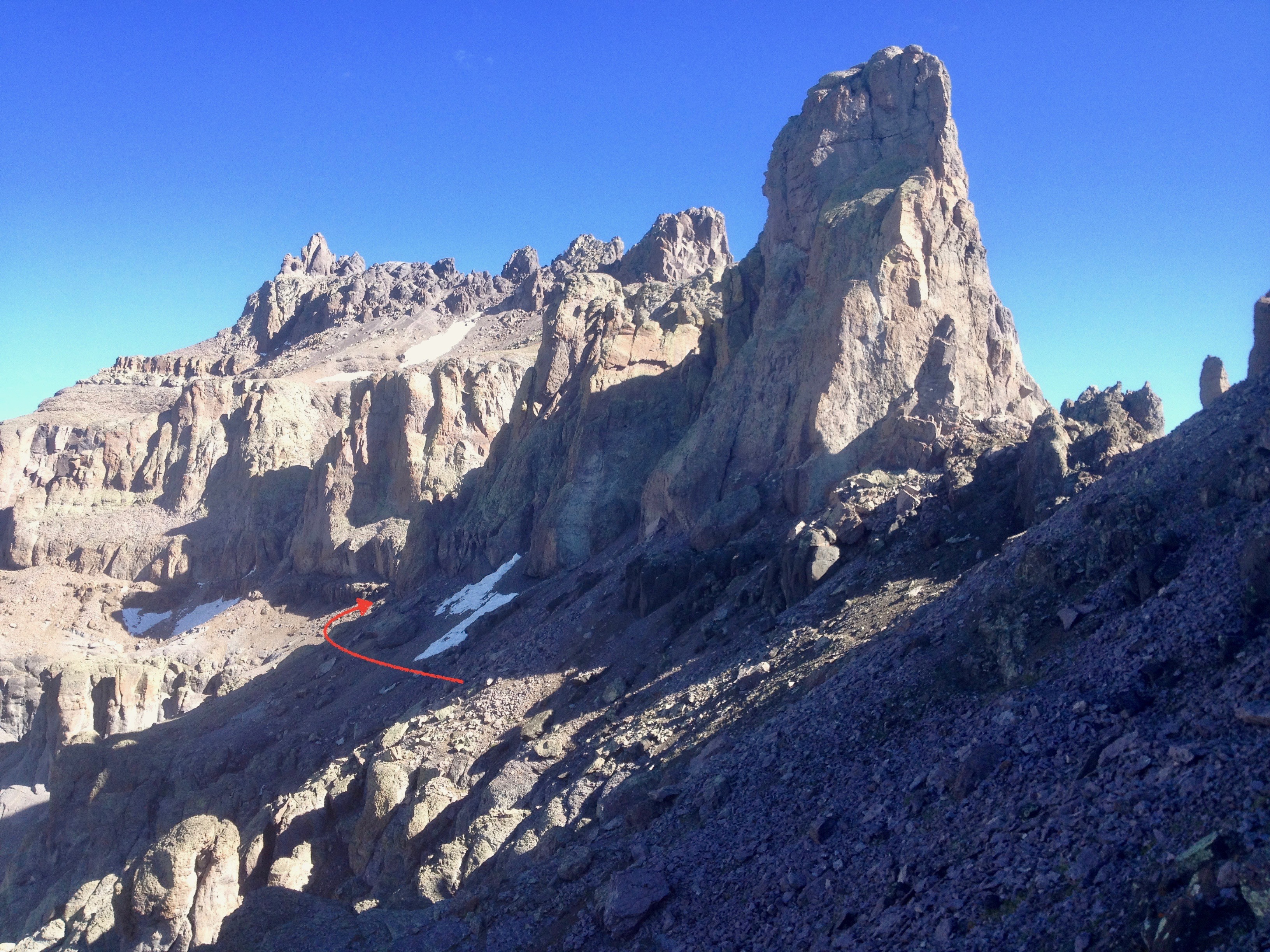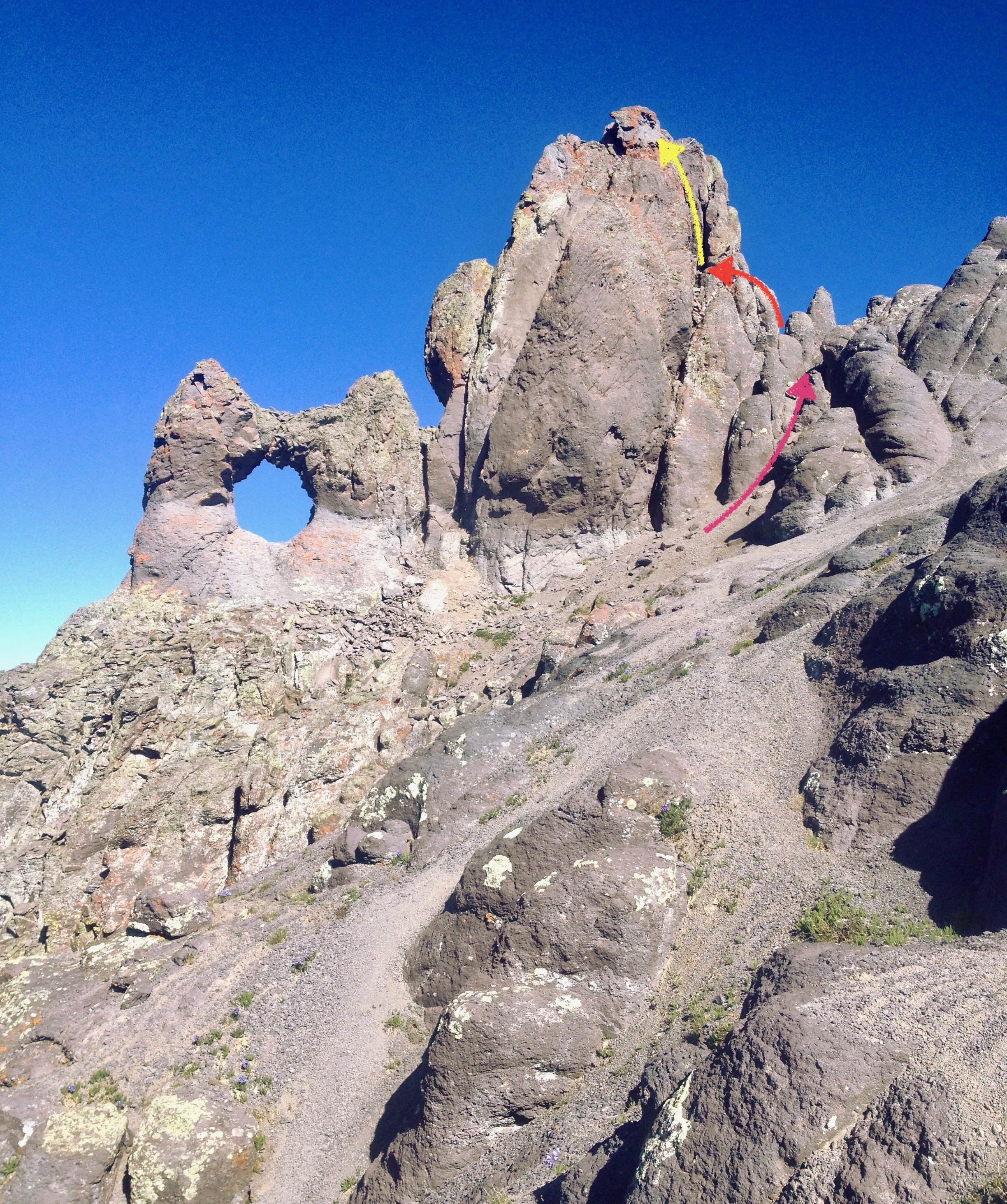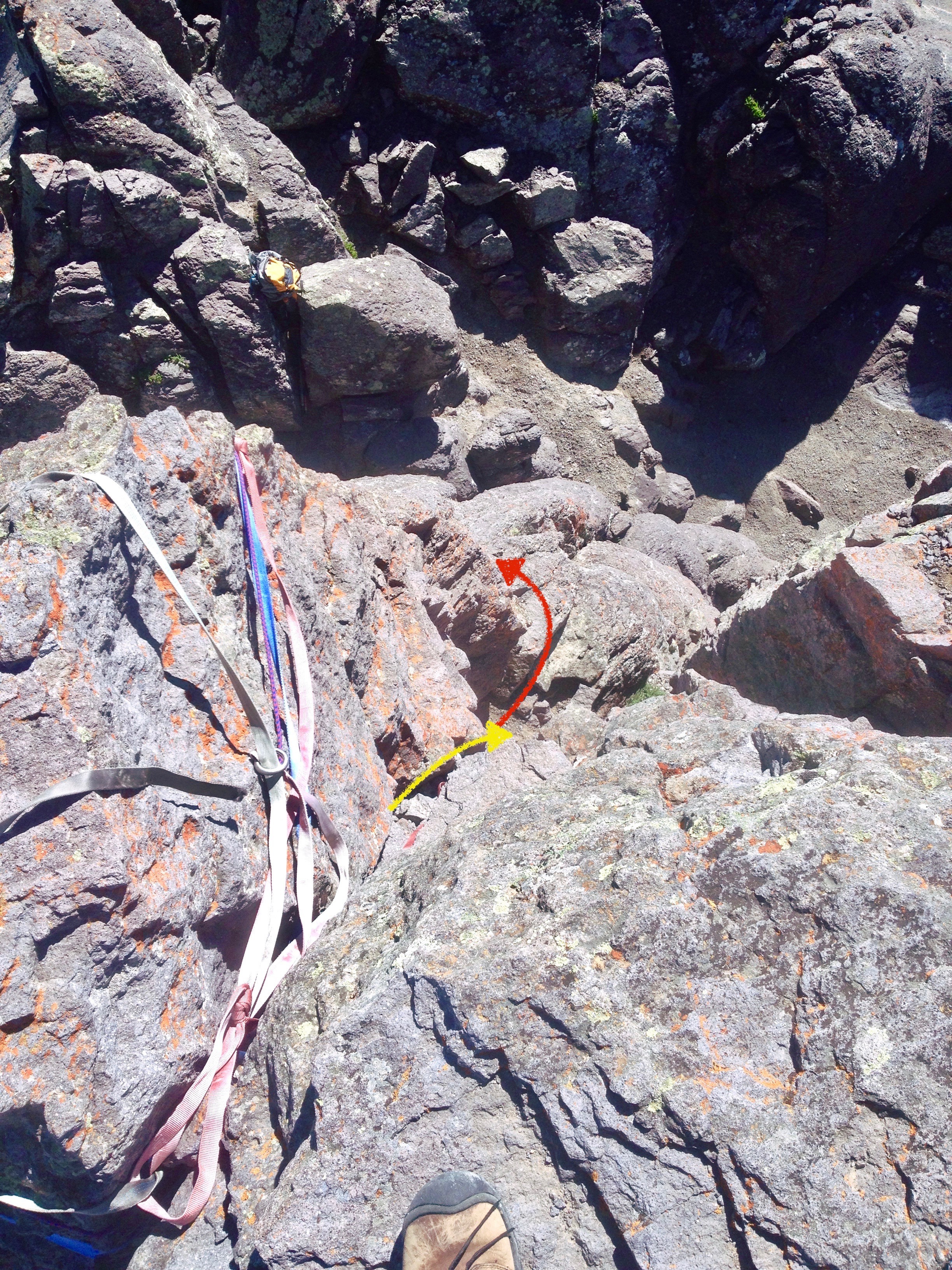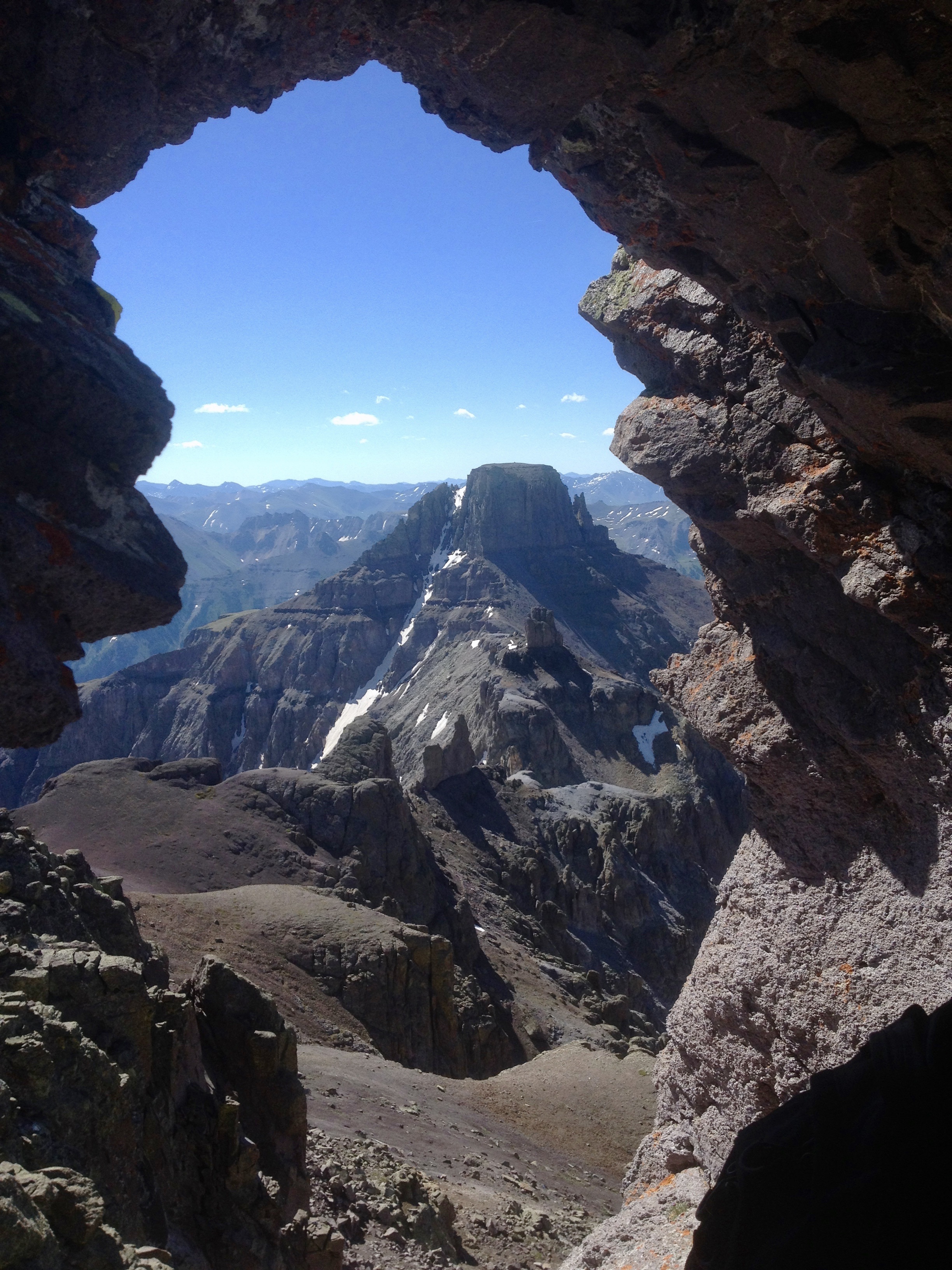LoJ: #102 (Pre-LiDAR #98) / 13,815' Teakettle Mountain
Peak Summary
Ahh. Finally - a 13er rated 5th class, but that's really only for the final 20 feet or so to obtain the true summit. The remainder of this peak is largely Class 2+ with a little Class 3 scrambling, and most persons with some rock climbing ability will find the summit obtainable without a rope, but it is comforting to have. SO, there's no need really for a full length rope or heavy rack of cams, etc. A helmet is probably your most useful item. Teakettle is best approached from Yankee Boy Basin and is located WSW of Ouray. A 4WD will get you to a high elevation start (11,200 ft.) and only 1.5 mile from the summit. Other vehicles will need to stop about 2 miles earlier but that still keeps the overall mileage a reasonable day. Teakettle combines easily with Potosi so you may as well plan on doing both if weather permits.
Teakettle SE Ridge Route
-
Trailhead
-
Yankee Boy Basin - Mt. Sneffles Trailhead
Road up Yankee Boy has recently been improved as of 2018. The shelf sections are now smooth & graded. There should be no issues for passenger vehicles to continue up to the start of the 4x4 section at the Governor Basin road turnoff (just past the Atlas Mill) other than the washboarded switchbacks and unrelenting steepness.
To access this trailhead, head south out of Ouray on Highway 550 up Red Mountain Pass for 0.4 miles. At the first switchback, take a right onto Ouray County Road 361 (aka 'Camp Bird Road")—a graded dirt road. Immediately after this turn, the road branches with the right fork taking off toward Box Canyon Falls. Take the left fork, (just continue straight ahead actually) which will lead you on a bridge over the creek before beginning the relentless climb up into Yankee Boy Basin. Continue past the turnoffs for Camp Bird Mine & Imogene Pass and across the famous, spectacular shelf section of the Yankee Boy Basin Road (CR 26). Keep going until the road branches to Governor Basin around mile 7.75. Passenger cars shouldn't have any issues making it to this point (usually).
NOTE: The best parking may be just before the Governor Basin Road turnoff back near the Atlas Mill.
If you're driving a 4x4 vehicle, continue right farther up the Yankee Boy Basin Road for approximately another 0.9 miles to a large pullout with a solar vault toilet at around 11,380'. The 4x4 road up to the bathroom is in great condition as of 2018 as well—no obstacles of any real significance. A little clearance and low gears are helpful, but there should be no difficult maneuvers up to the trailhead that a stock 4x4 can't handle. Even some crossover vehicles should be able to make it if driven carefully.
Camping
The only camping allowed in Yankee Boy basin is now restricted to Thistledown and Angel Creek Campgrounds. As of June 2018 the Angel Creek Campground was temporarily closed "due to hazard trees." At Thistledown, there is an overflow area on the north side of the road just past the main campground thta has three or four other sites which are "walk-in" sites.
About 100 yards past the solar vault toilet, a road turns off to the left that drops down a little, crosses a larger puddle and then swings up into an area of trees. There are about five primitive campsites in among these trees. IN 2018, we observed on two separate weekends, various groups openly camping here with tents & RV's. We are not sure if using these spots is truly permissible or not. One Forest Service ranger told us that camping on FS land is not permissible anywhere in the basin, however, she also pointed out that there are all kinds of old claims in this area that are not considered FS land and that some of these areas could be used for camping. That may be the case with the spot described here, however if not on FS land, then you are on a private holding of some kind. On another trip, our son saw several people up at the various turnouts on the 4x4 section camping in their vehicles, but no tents. When he returned to the car after his climb, there was a woman associated with a Yankee Boy Basin conservation group who was checking the area round the restroom and also the trail and level area above it for signs of camping usage. She was photographing and documenting everything. Camp at your own risk on this one!
Campsite Locations
Thistledown › N 37° 59' 37.84", W 107° 42' 01.64"8,760 ft. elevation
Route Map Photos
Route Info Teakettle SE Ridge
Click thumbnail to view full-size photo + captionRoute Description
Year Climbed: 2018Note: The following route descriptionj is provided by Shaun Cooney based on his ascent with Jon Bradshaw, summer of 2018. Carrie & Tim completed this climb in 1994. Any significant variations in the two ascents will be pointed out.
Due to the bevy of cliffs, spires, and steep slopes, there are not a lot of route variations available on Teakettle. Our route follows the "standard" route published by other authors such as Gerry & Jennifer Roach and Mike Garratt & Bob Martin.
To start this route, use the Mt. Sneffles Trailhead (4x4 Parking) at 11,380' in Yankee Boy Basin.
From the parking area, look for a use trail taking off directly across the road near a no camping sign. You can follow this trail, or remnants thereof, for a short distance through the initial stands of pine. Your goal is to reach the ridge coming off of Coffee Pot — a large rock outcropping midway on the ridge between Teakettle & Potosi. Once through the trees, follow the tundra up to a semi-level spot in the ridge around 12,600'.
From here, an ascent straight up the ridge crest is blocked above by a significant cliff band that becomes smaller and more broken as it wraps to the east. Begin angling to the east (right) and pick your way through the rubble toward what remaining tundra you can find. Set your trajectory upward toward a small break in the cliff band. There are two small ribs of rock near this gully that offer some small measure of stability compared to the surrounding slopes. Use these to aid your upward progress where logical. Scramble up the minor cliff band (class 2+) and continue toward Coffee Pot. It is not necessary to climb right to the foot of Coffee Pot. The farther up you go, the poorer the footing will become on the loose, small, broken volcanic rock.
From somewhere near the base of Coffee Pot, You may finally stand more erect and take a moment to survey the remaining route up Teakettle, basically to the left (north). The peak looks rather imposing from here, but the route finds ways to break through the quagmire of cliffs and spires with surprising ease (at least relative to the terrain). The immediate band of cliffs across the basin from you presents your first challenge. This band of cliffs is broken by a rubble-filled gully punctuated with dark rocks (commonly referred to as the "Black Gully"). This gully, while it looks foreboding from your current vantage point, is the route. It will appear easier as you approach.
To approach the black gully, descend a short distance (approximately 200 - 300 vertical feet) down the south ridge of Coffee Pot until a you encounter a break in the cliffs that allows easy access to the upper, rocky slopes of the basin that separates you from the black gully. If the snow has melted, look for a climber's trail skirting across the rock directly toward the black gully. No more than class 2 or easy class 2+ terrain should be needed to make this descent and traverse over to the black gully. NOTE: This slope tends to hold snow later into the summer, so depending on snow levels and time of year, an ice axe may prove exceedingly useful here. (Note: In 1994, Tim & Carrie did not descend down the Coffeepot south ridge but instead traversed around Coffeepot to the NW side of the formation and located another steep, snow-filled couloir to descend that took them to about 100 feet below the Teakettle/Coffeepot saddle.)
Ascend the surprisingly climbable—though still loose—black gully (class 2+) and exit to your left (class 3). Enjoy a briefly level perch and survey the rest of your route.
The next spot to aim for is a break to the west in the major band of cliffs now above you. Follow cairns and a use trail as you wrap along a bench of sorts on your way to a wide, sandy gully that breaks through this last major cliff band. Once up through these cliffs, follow the cairns, trail, and the most logical lines up the summit block of Teakettle, which is easily recognizable by the circle-shaped arch on its southern side that forms the "handle" of the teapot. The route will avoid following directly on the ridge line above with its pinnacles.
At the summit block, take a moment to survey the remaining 30'. This is the crux of the route. Two main lines emerge as options to ascend this final block, and both converge into a 10' crack immediately below the summit. The first line is a direct crack up to the summit which is punctuated with several tufts of tundra lower down. The second, and probably best, line is to aim for a small "saddle" to the right side of the summit tower. If you intend to rope up or use climbing aid, this is a good spot to ditch your pack and get your gear on.
From this perch, you can ascend an initial block, wrap around a small nose of rock, and reach the upper portion and final 10' of the crack to the summit. The climbing here is only class 4, or maybe low class 5. Experienced climbers will probably not need rope on this short pitch. The final climb up the last 10' of the crack to the summit requires only one major, committing low class 5 move, but the exposure is significant enough that rope may be desired for some. (We're not talking thousands of feet here, just minor exposure. If you fell, you would probably only tumble back to the gravelly slopes below.) Use your best judgement and climb to the top. There's room for only 2-3 people at most. The summit appears like a bunch of sawed-off tops of a pile of boulders.
To descend, either downclimb or rappel the summit block and retrace your steps over to the bottom of the black gully. If climbing Potosi also, continue back to the base of Coffee Pot, and then down the ridge to the Teakettle/Potosi saddle. If Teakettle is your only goal, it's possible to save yourself the re-climb up to Coffee Pot and descend the basin below you. This has been described by many as incredibly loose and one of the worst descents in the San Juans. Alternatively, you can re-climb to Coffee Pot, follow the ridge, and descend from the Teakettle/Potosi saddle. This option isn't exactly pleasant either, so choose your poison and prepare to drink deeply from it.
Additional BETA
Links to other information, routes & trip reports for this peak that may be helpful. -
